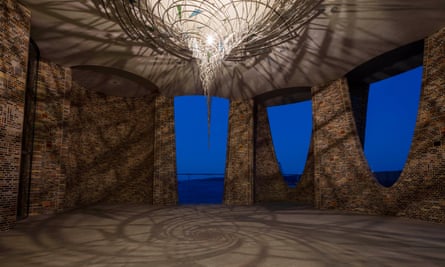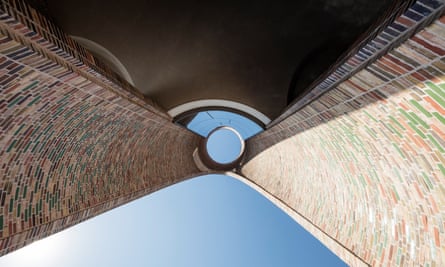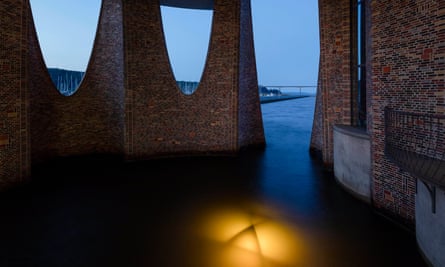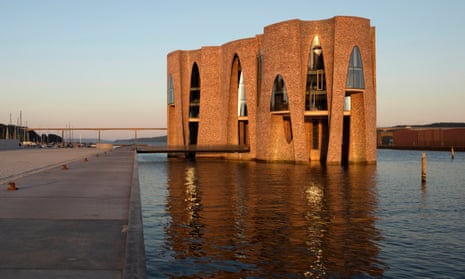Braced against the strong east wind whipping through the ground floor of his latest artwork, Olafur Eliasson relishes the low tide that accompanies it, revealing the algae that has formed on its brickwork.
“Finally, this looks like a living building, it feels like it’s growing in the water,” the Danish-Icelandic artist says, gazing on his Fjordenhus, which rises from the waters of the Vejle fjord in the Danish part of the Jutland peninsula.
This headquarters for Kirk Kapital, the holding company for three descendants of the founder of Lego, is the first building designed by Eliasson’s Berlin-based studio, taking to monumental heights his years spent working on hundreds of artworks, solar lamps and installations around the world.
“We were able to turn years of experiments in physical movement, light, nature, perception and the experience of space into a building that is a Gesamtkunstwerk [a total work of art] as well as a fully functioning architectural structure,” he tells the Guardian.
He worked on it for eight years with the German architect Sebastian Behmann, with whom he has collaborated since 2001, including on the celebrated 3D glass facade of the Harpa concert hall in Reykjavik.
Eliasson’s other flirtations with architecture include his 2007 Serpentine Pavilion in London, as well as the Cirkelbroen bridge in Copenhagen in 2014.
“We’ve worked for a long time now on parts of buildings, but we both had a strong feeling, ‘wouldn’t it now be nice to create an entire building as an artwork?’,” says Behmann, with whom Eliasson has formed the partnership Studio Other Spaces.
The resulting Fjordenhus is a towering, 28-metre-high brick construction made of four interlinking cylinders with spaces carved out of them, which are circular at one end and elliptical at the other, creating twisting curves and arched windows containing double-curved glass.
Seen at sundown from Vejle city centre it resembles a blazing lava lamp, the light catching on glazed bricks sprinkled across its facade.

Closer up, it is both imposing and inviting, disorienting and playful. Its curved rooms stretch out over the water and are furnished with Eliasson’s trademark installations, including a variety of giant spheres that reflect the shimmer of the water and the sun, following the arc of its path through the day.
Dubbed “Vejle’s new cathedral” by the local paper, the structure is predicted to put on the map a small city hitherto known for its chewing-gum factory, the iron-age bog woman in the local church, and a pork slaughterhouse.
Eliasson is insistent he is not trying to claim architectural prowess himself. “This is my artistic agenda in the shape of a building ... But the truth is, without Sebastian, this building would not be standing,” he says. “First, we have had the ideas and he has sought the solutions and pulled them through to reality, so that sometimes I was so overwhelmed, I started crying. Luckily he as the architect is emotionally much more contained.”
Fjordenhus, estimated to have cost upwards of 500m Danish krone (£59m), is due to open on 9 June and was commissioned by Kirk Kapital, the holding and investment company for three brothers who are direct descendants of the founder of Lego. It will serve as the headquarters of their foundation, but the brothers have insisted the ground floor, accessible via a footbridge, will remain publicly accessible.
Leading a tour around the building, Eliasson points out its slanted walls and curved ceilings, the underwater lighting stressing the ecological importance of the sea, and the almost 1m handmade bricks, rough and uneven when viewed close-up.
“I wanted to use them in an expressionistic way,” he says. “Of course, there’s the legacy of the Lego building bricks, which gave me my first lessons in abstract art when I was a boy growing up in Denmark.”

Eliasson says he was driven by the idea of a building “which celebrates people’s presence, which says: ‘I’m holding you’. It’s important for me to ask where does societal inclusion take place if not in architecture. The notion of the spaces we own together is shrinking – most extremely we see this in London.”
He says he has given even more thought to the importance of architecture and social inclusion since the Grenfell Tower tragedy and having observed wealthy oligarchs increasingly taking over London’s inner city.
“Clearly, London is one of the capitals where both the private sector and the wealthy individual have been given the highest priority, giving large parts of the city centre the total crazy bonkers real estate inflammatory situation, with no regulatory effort from the politicians to try and maintain a civic diversity. The result, forcing people to live at the periphery, creates a very unharmonious, monotopic community. The public sector has simply forgotten what it is to actually be driven by the belief in its own people,” he says.
He stresses a direct link between what he calls “this gross mismanagement which has left people feeling alienated, disrespected and marginalised” and Brexit. “It’s a devastating decision, which is going to backfire horrendously for the very same people who voted for it, which makes it even more sad.”
He is quietly defiant when asked to what extent the Fjordenhus – created for a multibillion-pound investment company and with security guards posted at the entrance – is different.

“This building is not strictly speaking public, although it was important for the clients that the public has access to it,” he says. “And the idea was to give the exterior of the building an active public statement, instead of resembling the fortresses of the financial district in London with their black granite, Death Star-style facades. The wealth of the clients, who are the least oligarchy people I know, was generated by the Lego company, which started with creativity and imagination. They are investing back in their local community.”
What Denmark has that other countries lack, he believes, is a strong sense of civic trust.
“In Denmark we talk a lot about civic trust: the sense of the welfare system as something we co-produce, not something we take. Some people will say this is an illusion, but at least the debate is here.”
Eliasson is perhaps best known for his 2003 Tate Modern venture The Weather Project, in which he transformed the Turbine Hall into a temporary solarium with an artificial sun that prompted visitors to lie on the floor and see their reflections in ceiling mirrors. He says that looking back, he gained from that a lot of the confidence needed to take on a project as massive as the Fjordenhus.
“It gave me confidence in the world. It made me realise how much culture is the single strongest driver of the notion of identity within our society. It also taught me don’t think you’ve thought something through before you’ve actually done it, because the thinking through is in the action.”
The Fjordenhus, he hopes, will be the first of many forays into architecture. He and Behmann are currently building a memorial park to the late president of Ethiopia in the hills north of Addis Ababa, as well as being involved in other projects from Paris to Berlin, including a kindergarten.
“We really hope the Fjordenhus will help get our ideas out there, and it will give other people confidence to do crazy things like this one elsewhere,” he says.
